It might seem totally crazy to claim this at what might be the height of the craze, but I’m worried that we we are ruining rosé. The incredible growth in production and popularity has meant that more wineries than ever before are pumping out pink, but sadly much of what’s been put into circulation over the last few years has been simple and uninteresting.
Rosé first rose to prominence in wine circles because it offered something of an elusive set of characteristics: quality, complexity, and value. Since pink wines in the US had for years been equated with White Zinfandel (namely sweet and syrupy), demand was weak, and many of the world’s best rosés could be had for a real value. Lighter-hued wines from the areas surrounding Provence got most of the attention, and for good reason. For a brief time, the rosé from Domaine Tempier was as popular on sommelier Instagram accounts as any other bottles.
-
Related Story: How To Escape The ‘Bermuda Triangle’ Of White Wine
There’s no doubt that this has done some real good for the popularity of rosé, and possibly even helped with quality. Yet it’s also created several divergent trends: one towards making as pale a rosé as possible, and the other towards turning just any old red grape into rosé.
In the first case, while I’m certainly a fan of many light, crisp, fresh rosés, there seems to be something of an arms race to see just how little color a winemaker can extract and still call it rosé. Since many consumers associate more color with more sweetness (White Zin strikes again!), the easiest way to convince someone that your rosé is dry is to have minimal color. While in certain cases, with certain grapes, this can make for a great wine, quite often these ultra-pale rosés are dull and watery, and often produced from high-yield grapes in truly dizzying quantities. The thrill of Provençal rosé was that it offered complexity and depth of flavor, earthiness and yet still a sense of freshness…not just vaguely cranberry-flavored alcohol water.
-
Related Story: 5 Questions You Always Wanted To Ask About Champagne
The other worrying trend is the attempt to turn any unwanted lot of red grapes (or red wine) into rosé, since there seems to be an almost endless market for the stuff right now. While there’s no absolute list of the grapes that should be made into rosé, it’s no surprise that many of the world’s best rosés are made from harder-to-ripen red grapes like Mourvedre, Grenache, Cinsault, and Pinot Noir. When more vigorous varietals are used, they often have to be picked at a very early stage so that the resulting wines are high in acid, leaving a rosé with little character…or they’re allowed to ripen more fully, leading to a rosé that’s essentially just a slightly off-dry, watered down red (goddamn it White Zin stay away from my glass!).
I’m not really trying to bemoan the “rosé as fashion accessory” trend, even if it does seem to have reached rather ridiculous levels lately, but as a rosé lover, I worry that the very popularity of rosé will ruin what was once so special about it. Let’s hope I’m wrong.
[gravityform id=”13″ title=”false” description=”true”]


